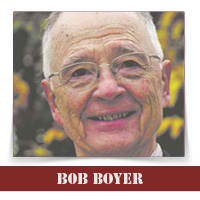
By: Bob Boyer
Daniel Immerwahr’s recent book, “How to Hide an Empire,” focuses on the U.S. as a colonial power, an empire in fact, in ways surpassing even the Spanish, French, and (yes!) the British. The book is alternately fascinating and irritating. Fortunately the information and insights outlast the occasionally snarky tone. After finishing the book my thoughts about it would not leave me any peace, despite my irritation, until I wrote some of them down. Also I’d already told my daughter who gifted book to me that I wanted to talk to her about it. She is an avid reader, as well as a professional statistician, so I realized I’d better have a few details prepared.
Here, and in a future column or two, are my first (and second) thoughts. I need to mention that I am, for the first time, working with an eBook, rather than a hard copy where I love to dog-ear and mark up pages. Also Immerwahr does not cite places in the text that he may expand on in his endnotes. I’ve attempted to check his endnotes, especially where I disagree with him, but I invite readers to check further to see who you side with. All quotations are from Immerwahr’s eBook.
One of the greatest U.S. losses in World War Two, in some ways militarily more consequential than Pearl Harbor, is the destruction of practically the entire Army Air Corps in the Philippines. It is also one of the enduring mysteries of the war. Why were the Americans surprised by the Japanese planes that didn’t arrive until nine hours after the attack on Pearl Harbor?
Immerwahr effectively details the sequence of events of the Japanese attack on Pearl Harbor, Hawaii, on December 7, 1941 (As evidence of hiding empire, he correctly points out that all other U.S. Pacific Island territories, are in a later time zone and thus their date of “infamy” was December 8, 1941. He asks why President Roosevelt didn’t include them in his famous speech, especially the Philippines, the largest by far.). The following is the sequence of events in the Philippines.
1. MacArthur receives the news by telephone at home (his “penthouse atop the Manila Hotel” Immerwahr can’t resist editorializing) at 3:40 a.m. Philippine time. He goes immediately to his command headquarters.
2. MacArthur’s air commander goes to headquarters twice. MacArthur refuses to see him both times.
3. MacArthur receives “repeated warnings from Washington,” even “direct orders,” all of which go unacknowledged. (Strangely Immerwahr doesn’t specify what the orders were that were ignored. Nor does he note that the order for the U.S. planes to deploy finally came and that many of the planes had done so and returned, not having found any incoming planes.)
*The Japanese planes arrive “sometime after noon, nine hours after Mac Arthur’s phone had rung,” and bombed the U.S. planes on Clark Airforce Base and a few other smaller fields; nearly all the planes were, shockingly, still on the ground. Immerwahr legitimately compares this catastrophe to the 1898 Battle of Manila Bay in which Dewey and the U.S. Fleet demolished the hapless Spanish Fleet while it remained confined in the harbor. Only now the U.S. was in Spain’s position.
I have read a few speculations as to why MacArthur failed to act in the nine hours between news of Pearl Harbor and the arrival of the Japanese planes. Only one struck me as helpful. It concludes that, given the poor weather conditions, the same that had delayed the Japanese planes, about half of the U.S. fighter planes would have had to be in the air constantly to have successfully intercepted the Japanese.
More helpful than speculations are Immerwahr’s stats: eighteen of thirty five B-17s (the vaunted Flying Fortresses) and “ninety other aircraft” destroyed and “many others” damaged. The “others” were either too damaged to get off the ground, or else they were unable to get past the bombed and strafed wrecks.
Most notably Immerwahr and his stats make clear that the U.S. actually did have a formidable air defense in the Philippines, but MacArthur’s seeming paralysis doomed it to failure. Like the Spanish in 1898, the U.S. lost “its fleet in a single day.”
Still, Immerwahr, to his credit, does not accuse or even criticize MacArthur (something he is happy to do frequently elsewhere) for the disaster. He refers to MacArthur’s proven military genius before and after the loss of the air defense, and accepts what others have said. It remains a “mystery.”
More to come.
Bob Boyer welcomes your comments at Robert.boyer@snc.edu.
 VIA Times – August 2019 Issue Vital News, Vibrant VIews for Asian Americans in Chicago & Midwest
VIA Times – August 2019 Issue Vital News, Vibrant VIews for Asian Americans in Chicago & Midwest

